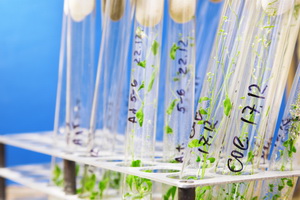
Discovery Brings Scientists One Step Closer to Crops with Twice the Yields
November 15, 2017| |
 Scientists from Wageningen University and Research have found natural genetic variation for photosynthesis in plants and are unravelling it to the DNA level. Led by Mark Aarts and Jeremy Harbinson, the research team has shown that thale cress has various genes involved in adaptation to the changes in the amount of light to which plants are exposed.
Scientists from Wageningen University and Research have found natural genetic variation for photosynthesis in plants and are unravelling it to the DNA level. Led by Mark Aarts and Jeremy Harbinson, the research team has shown that thale cress has various genes involved in adaptation to the changes in the amount of light to which plants are exposed.
A gene that has been studied in detail is the Yellow Seedling 1 gene, which is involved in the adaptation of chloroplasts to light changes. Due to a variation in this gene, some thale cress plants can handle an increase of light (the difference between a cloudy and a sunny day, for example) better than others. It is the first time that this variation has been found in thale cress, but as the genes for photosynthesis occur in nearly all plant species, the scientists expect that a similar variation can be found in many other crops too.
The discovery shows that it is possible to improve photosynthesis based on natural genetic variation, something which was doubted until now. In the long term, breeding on improved photosynthesis could make crops produce more yield with the same amount of soil, water, and nutrients. This brings the concept of ‘more' (yield) ‘with less' (soil, water and nutrients) one step closer.
For more details, read the news release from Wageningen University and Research.
| |
Biotech Updates is a weekly newsletter of ISAAA, a not-for-profit organization. It is distributed for free to over 22,000 subscribers worldwide to inform them about the key developments in biosciences, especially in biotechnology. Your support will help us in our mission to feed the world with knowledge. You can help by donating as little as $10.
-
See more articles:
-
News from Around the World
- Large US Study Says No Link Between Glyphosate and Cancer
- US Consumers Confused with ‘Organic' and ‘Non-GM' Food Labels, Survey Shows
- Biotech-improved Golden Potatoes Contain Higher Levels of Vitamins A and E
- Scientists Develop Tomatoes with Enhanced Antioxidant Properties through Genetic Engineering
- Indian Prime Minister Discusses Agri Innovations with IRRI Rice Scientists
- Biotechnology for Farmers Welfare and Poverty Reduction
- Wheat Genome Assembly Now Complete
- Discovery Brings Scientists One Step Closer to Crops with Twice the Yields
-
Research Highlights
- Sarcotoxin IA Gene from Flesh Fly Confers Enhanced Resistance to Citrus Canker in Sweet Orange
- Scientists Use Cre-lox Gene Switch to Limit Bt Gene Expression in Green Tissues of Rice
- Lowered Expressions of BnFAD2 and BnFAE1 Improve Seed Nutritional Quality in Rapeseed
-
Beyond Crop Biotech
- Australian OGTR Receives Application for Limited and Controlled Release of GM Buffalo Grass
- Silencing of Midgut-Expressed Genes in Lepidopterans through Ingestion of RNAi Expressing Plants
-
Plant
- Researchers Use Viruses as Delivery Vectors for CRISPR-Cas9
- Development of Low Cadmium Elite Indica Rice Cultivars via CRISPR-Cas9
-
Read the latest: - Biotech Updates (December 10, 2025)
- Gene Editing Supplement (November 26, 2025)
- Gene Drive Supplement (February 22, 2023)
-
Subscribe to BU: - Share
- Tweet
